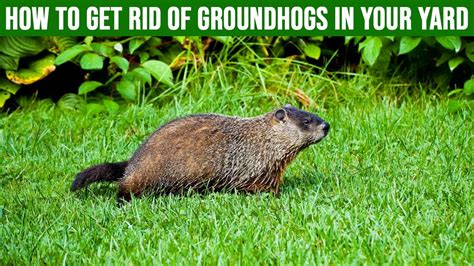Groundhogs, also known as woodchucks, are large rodents native to North America. These creatures are known for their distinctive appearance, with their brown fur, short tails, and large, chisel-like teeth. While groundhogs can be found in various habitats, including forests, fields, and meadows, they often venture into residential areas, where their presence can cause significant damage to yards and gardens.

The Destructive Habits of Groundhogs
Groundhogs are burrowing animals, and their extensive tunnel systems can wreak havoc on your yard. Their burrows can damage underground utilities, such as water and gas lines, and create tripping hazards for both humans and pets. Additionally, groundhogs’ digging habits can disrupt the root systems of plants and trees, leading to their decline or death.
Damage to Plants and Gardens
Groundhogs are voracious herbivores, and their appetites can extend to a wide variety of plants and vegetables commonly found in yards and gardens. These animals are known for their preference for leafy greens, including lettuce, spinach, and cabbage. However, they will also consume beans, tomatoes, cucumbers, and even flowers. The damage caused by groundhogs can be substantial, resulting in reduced yields and even complete crop loss.
Health Risks Associated with Groundhogs
Groundhogs can carry various diseases and parasites that can be transmitted to humans and pets. These diseases include tularemia, salmonella, and Lyme disease. Additionally, groundhogs’ burrows can attract fleas and ticks, which can further increase the risk of disease transmission.
Benefits of Groundhogs
Despite their destructive habits, groundhogs can provide some benefits to the environment. These animals are important prey species for larger predators, such as coyotes, foxes, and eagles. Additionally, groundhogs’ burrowing activities help aerate the soil and improve drainage.
Humane Groundhog Removal Methods
If groundhogs have become a nuisance in your yard, there are several humane methods available for their removal. Trapping and relocation is a common approach, but it is essential to follow all applicable laws and regulations. Groundhogs can also be discouraged from entering your yard by fencing, planting deterrents, and removing potential food sources.
- Install a fence: A fence made of sturdy wire mesh can effectively deter groundhogs from entering your yard. Ensure the fence extends at least 2 feet below the ground to prevent them from digging under it.
- Plant deterrent plants: Certain plants, such as marigolds, daffodils, and garlic, emit scents that groundhogs find unappealing. Planting these plants around your yard can help keep them away.
- Remove food sources: Keep your yard free of fallen fruit, pet food, and other potential food attractants for groundhogs.
- Trap and relocate: If other methods fail, you can trap groundhogs and relocate them to a suitable habitat away from your property. Always consult local regulations and seek professional assistance if necessary.
Groundhogs can significantly impact your yard and garden. Their burrowing habits, destructive feeding, and potential health risks make them a nuisance in residential areas. However, by understanding their behavior and employing humane removal methods, you can effectively mitigate the damage caused by these creatures and enjoy a pest-free yard.
